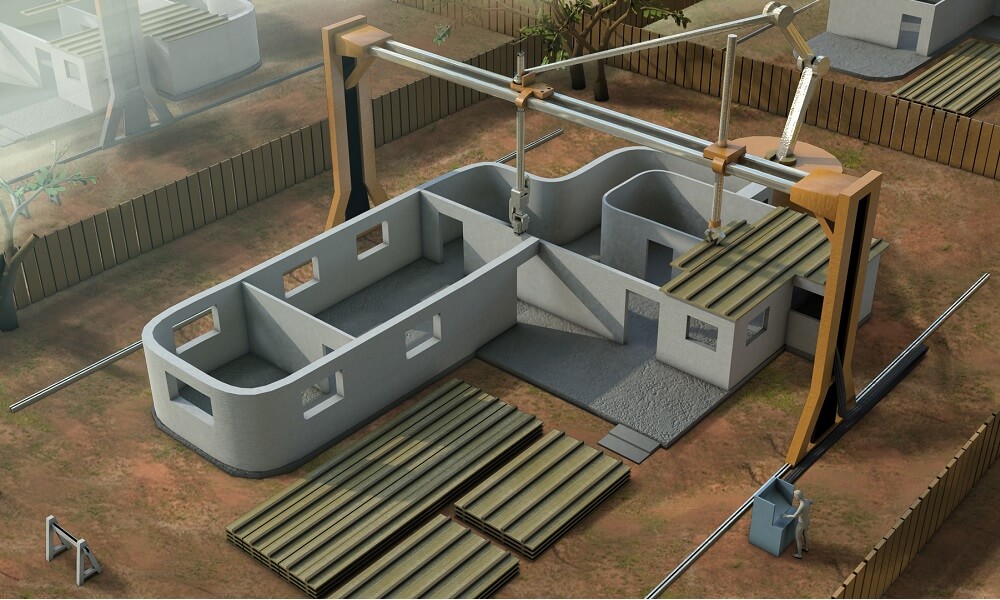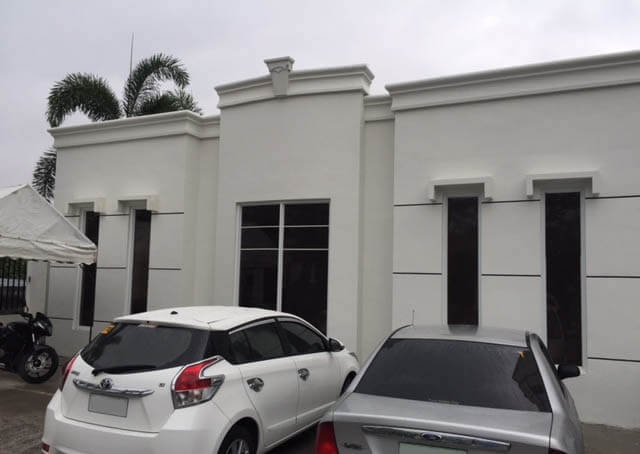3D printing for construction: What is Contour Crafting?
Posted By Lucie Gaget on Jun 27, 2018 | 0 comments
3D printing is evolving quite quickly, and new technologies are unveiled regularly. Indeed, it is a real hotbed of technological innovations. Additive manufacturing now has a lot of applications and tends to go even further year after year. Today we are going to tell you about Contour Crafting, a 3D printing method specifically used in the construction sector, allowing to print XL constructions. Let’s discover what is Contour Crafting, how it can be used, and how it will revolutionize the construction sector. We are also going to see the various applications of this technology.
Contour crafting: A new 3D printing technology
What is Contour crafting?
What we call Contour crafting is a 3D printing method allowing to build constructions at an architectural scale. This printing technique has been researched by Dr Behrokh Khoshnevis at the University of Southern California’s Information Sciences Institute. The Dr Behrokh Khoshnevis worked on a machine able to build homes developed the Contour crafting technology.
Concretely, how does it work? Contour crafting requires a big construction 3D printer, to print layer by layer any type of infrastructure. Most of the time, these construction 3D printers are printing these large-scale projects with a crane or/and a robotic arm. Regarding the 3D printing materials used for Contour crafting, quick-setting materials are used, like concrete or sand.
Here is how these XL 3D printers look like:
http://contourcrafting.com/
Contour crafting is an automated construction process, that is now progressively allowing to save time and money while creating impressive constructions. Now, some 3D printers are able to print at an architectural scale with new materials. Indeed, concrete 3D printers are now entering the market, and they represent a big challenge for the construction sector. Get more information right here.
3D printing is a huge advantage for architecture, to create models, for visualization, and even for bigger projects. Check out our selection of the best 3D modeling software for architecture if you are interested in these 3D printing applications for architecture.
Contour crafting, a technology with many advantages
Contour crafting has a lot of benefits for architecture. Indeed, it is allowing to print buildings or any infrastructures directly on place. It could become a common method to help in building constructions for people in need, like houses, or buildings. But these machines are capable of printing any urban settings or any infrastructures, such as bridges. As it is printing projects in one part, it is allowing to create more complex designs, not doable with traditional construction techniques. Architects could be free to create all the designs they want thanks to this technology.
It is a really fast and efficient technique to create houses. For example, it appears to be a really good method to print emergency homes after natural disasters. You can get a 3D printed house directly on the construction site, in only a few hours and at a lower cost.
This technique offers the possibility to build different kind of project really efficiently. Moreover, less manual labor is needed to print a full building, as the process is automated. Contour crafting appears to be a cost-effective technique to build architectural constructions.
Applications of Contour crafting
We are going to see what are the numerous applications of Contour crafting and how it is revolutionizing the construction sector. Building constructions for the urban space is becoming possible thanks to the use of 3D printing, and these new robotic 3D construction printers.
Contour crafting helps to build houses in 24h
3D printing large-scale infrastructures is a revolution for the construction sector. For example, it is now possible to build homes in only 24h, which could be a great solution to help victims of natural disasters.
This incredible experiment has been led by a Chinese company WinSun Decoration Design Engineering. They built ten houses in only 24 hours. They actually 3D printed ten houses in 24h, the proof that 3D printing is unbeatable when it comes to efficiency and rapidity.
Watch the video below for more details about this impressive experiment:
To see more 3D printed home projects, check our blogpost.
3D printed buildings
This 3D printing process is allowing to build project bigger than a house. The Contour crafting technology offers the possibility to create buildings, like this one, 3D printed by Andrey Rudenko. It is a hotel, and this is also the proof that a lot of different places and building are printable, from hotels to workspaces. It is allowing to rethink totally the designs of these places and create original creations.
http://www.totalkustom.com/3d-printed-hotel-suite.html
3D printed bridges
Contour crafting is not only a great solution for housing projects, these new 3D machines are allowing to print a lot of different architectural infrastructure. Have you ever heard about 3D printed bridges? For the moment, it is more convenient to print pedestrian bridges instead of bridges for big roads and heavy automobiles. It is a great way to design new kind of bridges, but also to quite convenient as this technology enables to print these infrastructures in only one part.
If you are interested by 3D printed bridges, be sure to check out our blogpost about 3D printed bridges.
Space applications of Contour crafting
Contour crafting is a great solution to print in remote area, almost inaccessible or where it would be too expensive to send these large-scale infrastructures in space. We already saw that 3D printing was a great advantage for space missions.
This printing technique could be used to create infrastructure on Mars or on the moon in the upcoming years, using materials found on place. This automated construction process could be the solution to create an entire base in these areas!
Here is an insight of what could the NASA could do with this technology:
Contour crafting, an eco-friendly alternative
This contour crafting technology is an eco-friendly alternative on different levels. First, the 3D printing materials that are used to build homes or other infrastructures are materials with a low ecological footprint, such as sand, and these construction 3D printer are more and more using the solar energy to function.
Moreover, another eco-friendly aspect of this technology is that there is no material waste. Indeed, one of the benefit of 3D printing is that this technology is avoiding material waste, you only use the amount of material that you need for your project.
The future of Contour Crafting
XL 3D printing is now a reality, and companies are more and more looking for bigger 3D printers. Indeed, with metal 3D printing, large-scale 3D printing is one of the most anticipated technologies in the 3D printing industry!
Robotic construction could really allow to solve housing problems and build homes in remote areas, for example. And as you can see, even if these printers are already capable of printing amazing project, this 3D printing technology has still a lot to offer and could be even more efficient and accurate in the upcoming years.
The future of this cutting-edge technology is really promising and could help a lot of people. Additive manufacturing can be used in various sectors, and the construction sector is one of them. Deployable robotic is, without a doubt, the future of architecture.
If you want to read more articles about the innovations and the latest 3D printing news, don’t hesitate to subscribe to our weekly newsletter!
Image: © Contour Crafting


 Connect with Google
Connect with Google Connect with Facebook
Connect with Facebook
